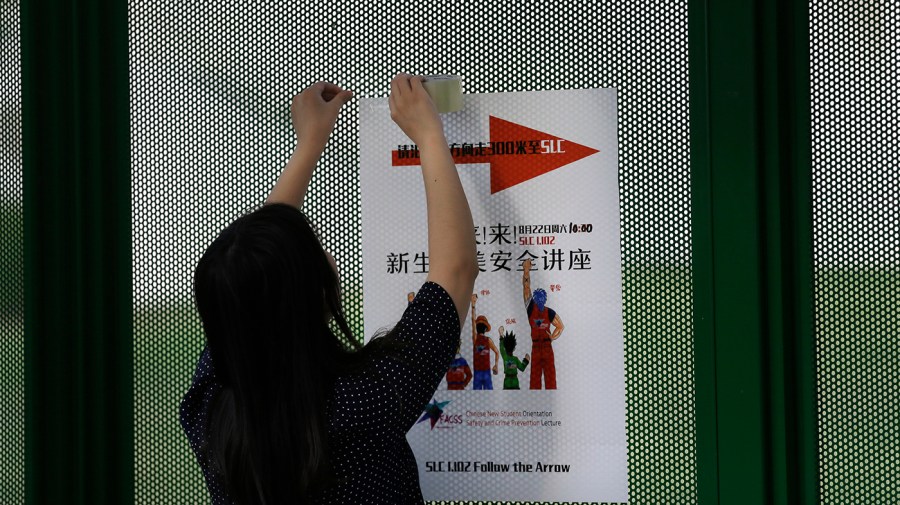Foreign students face murky visa conditions under Trump

International students looking to study in the U.S. are getting very mixed signals from the Trump administration.
Days after President Trump said it is “very important” to have Chinese students at American schools, prompting backlash from his MAGA base, his administration proposed a rule change capping a foreign student’s stay to four years to complete a degree and requiring special approval to stay longer.
“For too long, past Administrations have allowed foreign students and other visa holders to remain in the U.S. virtually indefinitely, posing safety risks, costing untold amount of taxpayer dollars, and disadvantaging U.S. citizens,” a Department of Homeland Security (DHS) spokesperson said in the release.
But hundreds of thousands of foreign students in the U.S. are graduate students, with a Ph.D. program taking as long as eight years in some cases.
Experts worry the new approval won’t be a smooth process would disrupt international students’ studies, causing them to seek universities in other countries despite the president looking for more students to come to the U.S.
Trump had already made sweeping student visa crackdowns a key part of his immigration policies, with the State Department announcing in August that more than 6,000 such visas had been revoked since he returned to office. Foreign students are also dealing with new screening procedures than have many scrubbing their social media in fear.
And now, in order to stay in the U.S. for a longer degree, they would have to apply to reauthorization through the United States Citizenship and Immigration Services (USCIS).
The problem, advocates say, is that USCIS is already backed up, and delays in reauthorizations would put education plans at risk.
“If we had a well-oiled machine at USCIS working to make these approvals happen quickly, it wouldn’t be as much of a problem. This is bad policy because it will make USCIS processing even more backlogged, and that’s going to make it harder for students to gain legal approval to stay in the United States,” said Jill Allen Murray, deputy executive director of the Association of International Educators.
The Hill has reached out to DHS for further comment.
Others advocates questioned the administration’s argument that widespread abuse has occurred by previously allowing students to apply just once.
“We looked at what they put in the rule and in the justification for the rule, and they said that there were about 2,100 people who came in between the year 2000 and 2010 that were still in active F-1 status. We calculated what that meant, that meant that comes to 0.06 percent of the estimated more than 3 million people who came in as F-1 students on visas during that time period,” said Stuart Anderson, executive director for the National Foundation for American Policy.
“So, to justify putting new burdens on 99.93 percent of international students … that doesn’t seem like a very intelligent approach, and it seems more grasping at a justification rather than an actual reason,” he added.
The rule proposal adds to an already confusing situation after Trump last week emphasized that students from China would still be welcome, despite Secretary of State Marco Rubio earlier saying he planned to “aggressively” revoke visas from Chinese students, particularly those “with connections to the Chinese Communist Party or studying in critical fields.”
“I hear so many stories about, ‘We’re not going to allow their students,’” Trump said last Monday. “We’re going to allow their students to come in. We’re going to allow it. It’s very important — 600,000 students. It’s very important.”
While China has been one of the top exporters of foreign students to the U.S., in the 2023-2024 school year, only around 277,000 Chinese students came to the country. Trump specified in an interview released Sunday that the 600,000 figure referred to “over two years.”
The original comment raised eyebrows on the right, especially after Commerce Secretary Howard Lutnick said the “bottom 15 percent of universities and colleges would go out of business in America” without foreign students.
“I think it just goes to underscore the mixed signals that are happening between China and the U.S. and just between — with international student visas in general,” said Michael Hansen, senior fellow at the Brown Center on Education Policy at the Brookings Institute.
“On the one hand, they signal that they want international students here, at least on the campaign trail Donald Trump did talk about giving basically green cards to people with an American degree in order to keep them here,” Hansen added. “At the same time, there’s also these moves to illegally block student visa holders for other grounds that have not been imposed previously.”
Advocates say these policies are going to harm interest in the U.S. for higher education and hurt local economies.
“Using international students as geopolitical pawns sends a deeply unwelcoming message to current and prospective students. It undermines global confidence in the U.S. as a stable and welcoming place to study, work, and invest in one’s future. The chilling effect of these policies goes far beyond the international student population. It threatens our economy, our communities, and the educational experience of American students as well,” Zuzana Čeplá Wootson, deputy director of federal policy at the Presidents’ Alliance on Higher Education and Immigration.